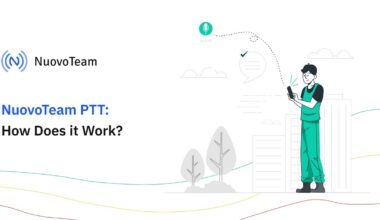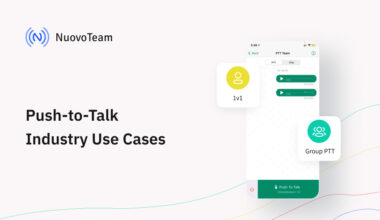Construction job sites can be extremely dynamic in nature. From dealing with harsh environments with dust, water, noise and heavy machinery, to enduring accidents and hazards, construction workers have to face it all. For construction businesses, ensuring the safety and efficiency of the employees is of prime importance. This is why push-to-talk apps are gaining popularity in the construction industry.
Sticking to age-old technology like walkie-talkie radios, or irrelevant modes of communication like phone calls and emails can make you lose your competitive edge quickly. Push-to-talk solutions ensure that your on-site workers, contractors, architects and managers stay well-collaborated in the most reliable and safe way possible.
What Are Push-to-Talk Apps?
Push-to-Talk (PTT) apps are tools that allow users to turn their smartphones into walkie-talkies. You can leverage the same walkie-talkie-like two-way half-duplex communication with just the press of a button. But what makes these push-to-talk apps different from traditional walkie-talkie radios is that they can be seamlessly integrated into smartphones and offer connectivity over cellular networks like 3G, 4G and WiFi. Professional PTT apps allow businesses to monitor their remote employees, and team performances and configure settings and restrictions using a web-based console.
What Are the Challenges in Construction?
The nature of the construction industry demands workers to engage in heavy-duty operations daily, work in remote locations, coordinate with multiple teams, and at the end of the day maintain high productivity levels. But, like all other industries, the construction industry has its unique set of challenges.
- Inaccessible Workforce: Construction businesses involve a large number of site workers, contractors, supervisors, and several other people of various skill sets and hierarchical levels that operate from dispersed locations. While workers operate in remote locations, managers may work from distant head offices. Using job aids can help in catching hold of the distributed workforce, updating them with the necessary information, and monitoring employees and daily operations remotely, making this gigantic task more manageable.
Unlike traditional office spaces wherein employees are constantly using their desktops, receiving emails and executing timely reverts, construction workers sport bulky protective gear and work in rugged environments. Trying to reach the construction workforce via phone calls, emails or text messages is nearly futile.
- Health and Safety Hazards: Construction sites are harsh and hazard-prone. Reports indicate that there were 1,74,100 cases of injuries in the construction sector in 2020. Businesses struggle to keep create an effective crisis communication plan. Without it, employees working on-site are left with no proper plan of action when an emergency strikes. Electrocution, fire outbreaks, falls and equipment failure are all causes of fatalities on construction sites.
A crisis communication plan involves training workers to identify hazards, use a reliable tool to communicate the emergency and leverage fast help. However, most businesses lack a crisis communication plan and enter into a state of frenzy, thereby threatening employees’ lives. - Information Silos: The inability to pass on the updates and information on an organizational level leads to non-uniformity and confusion. For remote working to be effective, it is essential for businesses to generate SOPs that ensure all the latest updates are relayed effectively and on time to every employee of the organization.
Unfortunately, this does not always happen when you have a distributed team of construction workers. Managers find it difficult to get hold of their employees resulting in a stream of missed calls and unattended messages or emails. The employees on the other hand find it impossible to keep a track of the company’s happenings amidst the heavy-duty on-field operations. All this ultimately leads to an unengaged and unproductive workforce. - Use of outdated technology: When it comes to staying connected, construction businesses must think outside of the box. Sticking to outdated tools and technology simply leads to greater complexities. Whereas, adopting complex technology that can only be used by the most tech-savvy employees also doesn’t bring in the desired results. It is important to weigh the requirements, consider the environment in which employees will be working and assess the offerings of the tools and technologies that you plan to implement beforehand.
After examining the major roadblocks that the construction industry faces, it appears that a lot of the challenges revolve around improper communication. These roadblocks can be easily resolved by implementing a communication platform that is easy to use and reliable. This is where push-to-talk apps play a pivotal role.
How Do Push-to-Talk App Benefits the Construction Industry?
Push-to-Talk apps basically help construction companies replace their outdated walkie-talkie radios with a modern alternative. Here’s how push-to-talk solutions benefit the construction sector.
1. Ultra-fast Push-button Connectivity
Construction workers can benefit massively from the one-touch connectivity that push-to-talk apps offer. Unlike regular phone calls or formal emails that require lengthy dialing and typing procedures, all you have to do with a PTT app is press a button and talk. This feature saves time and keeps the conversation going in bustling environments.
2. Enhanced Crises Communication
Emergencies have to be factored in given the nature of the construction work. Push-to-talk apps play a vital role in creating a strong crisis communication plan. Professional PPT apps allow users to send emergency alerts and broadcast messages using dedicated SOS channels to leverage faster help. When lives are on the line, such powerful features prove extremely important.
3. No Need for More Than One Device
Executing manual work using heavy-duty machinery and bulky protective gear is difficult as it is. Carrying multiple devices in their pockets is the last thing construction workers would want. Smartphones are owned and used by almost everyone these days. Turning your smartphone into a walkie-talkie saves employees the hassle of carrying multiple devices on-site and switching between them endlessly.
4. Easy 1-1 or Group Communication
You can connect with your on-site crew members, contractors, managers or head office using Push-to-talk over cellular connectivity. Start a PTT conversation with an individual, or create public and private channels to conduct group discussions effortlessly. Unlike phone calls that make you go through a dozen steps to add multiple users on a call, PTT apps make the process much easier.
5. Cost-effective Approach
Think of all the money you save when you decide to opt for a subscription-based push-to-talk solution instead of purchasing expensive dedicated devices like walkie-talkies. PTT apps help construction businesses prevent excessive expenditure on buying radio devices or the licenses and permissions associated with them.
6. Hands-free and Eyes-free
Broadcast messages are an effective mode of communication, especially for field employees like construction workers who may not always be able to grab their smartphones from their pockets in the middle of work. PTT apps allow messages to be broadcasted which are played loudly on the user’s end as and when received. This presents a hands-free and safe approach to keeping your workforce updated.
7. Beyond Radio Communication
Lastly, push-to-talk apps offer everything a traditional walkie-talkie does and so much more. Employees can use the walkie-talkie-like easy and quick push-button connectivity to their advantage without dealing with the drawbacks of radio communication. PTT apps offer high-quality audio, that does not rely on line-of-sight connectivity and is encrypted, unlike two-way radios.
NuovoTeam: Simplifying Communication Across Locations
Are you already considering opting for a push-to-talk solution? Well, we have the ideal solution for you. NuovoTeam is a push-to-talk app designed to turn your Android, iOS and rugged smartphones into a walkie-talkie. Keeping your workers, technicians, architects, managers, contractors and everyone else cannot get easier than this.
Besides all of the above-mentioned features that PTT apps provide, here’s why your construction business needs NuovoTeam:
- Desktop PTT: Your office staff can make PTT calls straight from their desktops or PCs with NuovoTeam’s desktop PTT. It works on any machine with a Chrome browser. No need to constantly switch between your PC and your smartphone.
- Team performance tracking: Supervisors and managers can gain enhanced visibility of their distributed employees with location tracking, attendance monitoring and analytics on the remote employees. No need to reach out to your employees every hour just to take updates, your dashboard presents deep insights for you.
- Live voice playback: Your employees need not worry about missed PTT calls. NuovoTeam lets employees access PTT history and replay previous PTT messages any number of times.
- Corporate directory sync: Need to get in touch with someone from the organization who you have never spoken to before? No need to spend precious minutes hunting for contact information. NuovoTeam allows businesses to sync their corporate directories for easy contact management.
- Short learning curve: NuovoTeam presents a simple user interface that can be used even by the most non-tech-savvy people. Your employees need little to no training to efficiently use the tool.
Your business deserves the best of what aligns with its needs. Try NuovoTeam to simplify your remote field communication.







